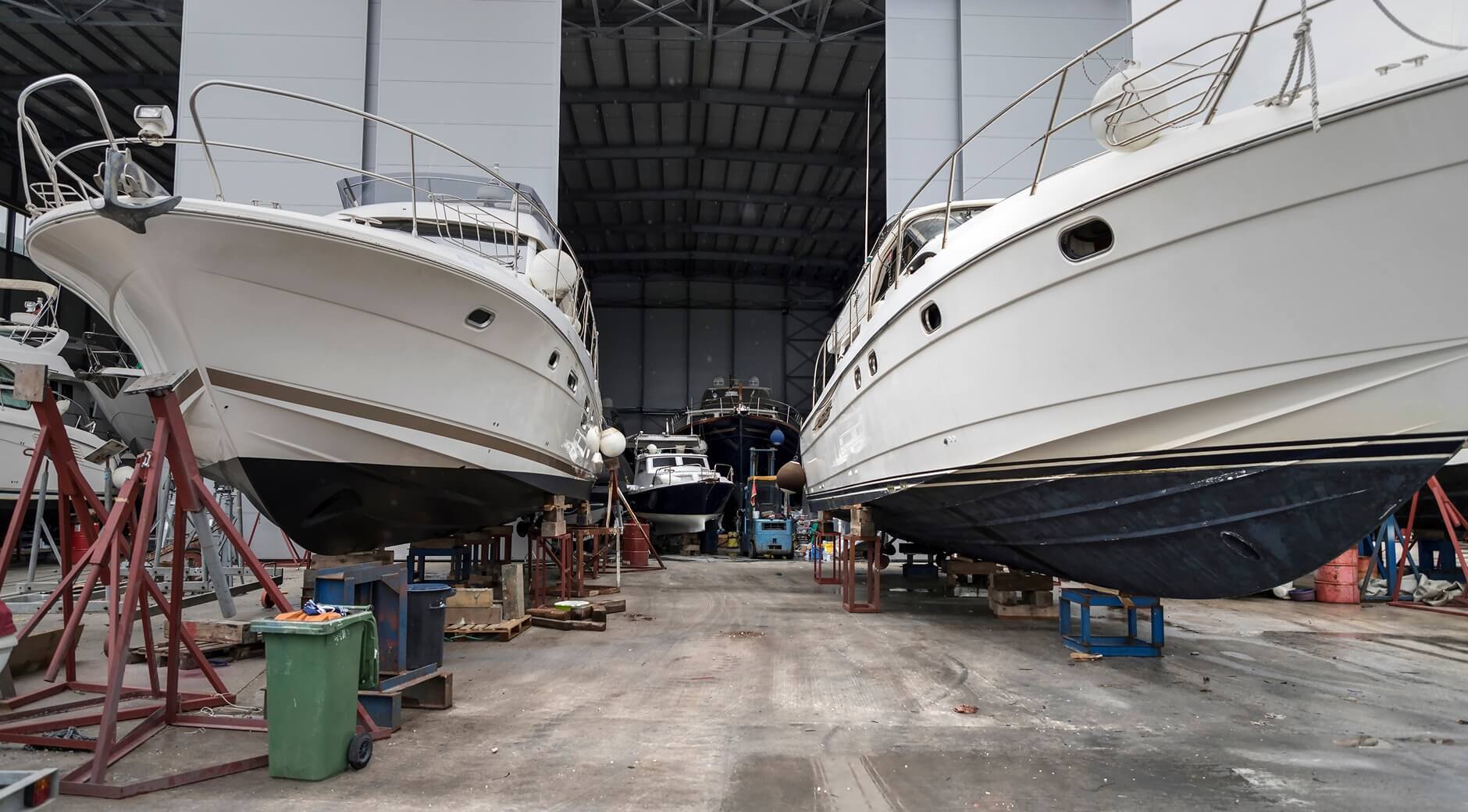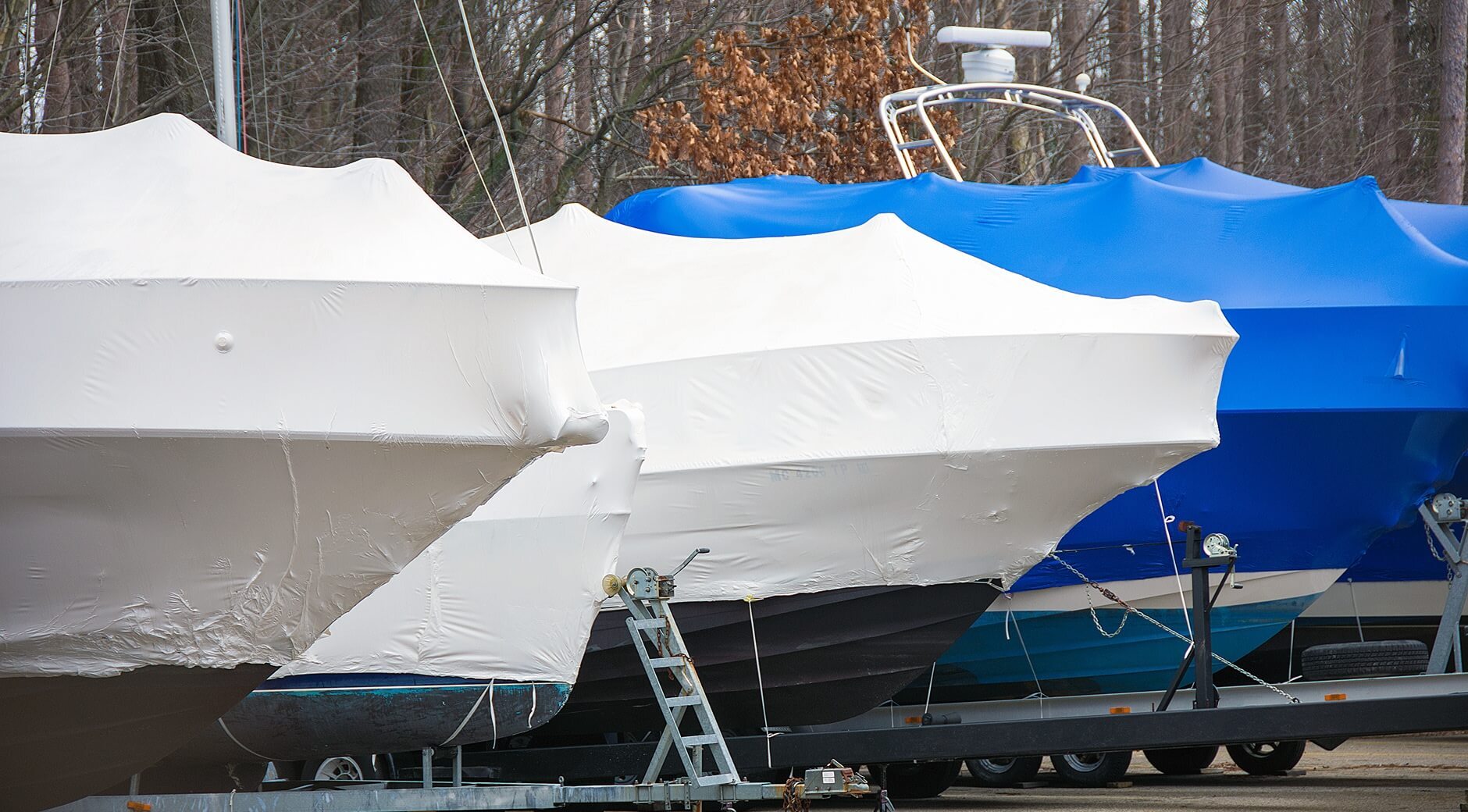
Boat storage isn't at the top of any sailor's list of fun things to do, but we can all agree it's gotta be done and done right. If you want to keep your rig looking sharp, running smooth, and ready to launch when the season kicks off, proper storage is the name of the game.
Whether you're bracing for winter or just need a solid off-season plan, we've got you covered. Let's talk about how to store a boat and various storage options (indoor, outdoor, DIY in your own driveway), break down the pros and cons, and share real-world tips to help you avoid common headaches. We'll cover mildew, cracked hoses, dead batteries—the stuff no boater wants to deal with come spring.
Got your gear? If not, Wholesale Marine makes it easy to stock up on boat maintenance supplies and everything else you need to keep your boat protected while it waits for the next adventure.
Article Contents:
Where to Store a Boat: Indoor vs. Outdoor vs. Self-Storage
You're ready to tuck your vessel in for a long nap, but where to store that boat? That's the million-dollar question. Each storage option has its perks (and quirks), depending on your budget, location, and how hands-on you want to be.
Indoor Storage: Top-Shelf Protection (at a Price)
If you've got the budget for it, indoor storage is about as good as it gets. It's like putting your boat in a climate-controlled cocoon, away from UV rays, rain, snow, critters, and salty air. You won't have to worry about fading gelcoat or mystery mildew when you uncover it next season.
The downside? It's not cheap. Storage at a marina or indoor facility can get pricey, especially during peak season. Space is also limited, so you'll want to book early if you're going this route.
Outdoor Storage: Convenient and Cost-Effective
Storing a boat outside, whether it's at home, on a trailer, or at a yard, can save you a chunk of change. But exposure is the tradeoff. Sun, snow, rain, and fluctuating temperatures can take a toll on your hull, upholstery, and electronics.
If you go this route, invest in a solid cover or go all-in with shrink wrap. And don't forget ventilation. You don't want to open her up in spring and get hit with a wall of damp funk.
If you're storing near the water, now's the time to check your boat dock and mooring gear. A saggy line or cracked cleat can undo all your prep work in one winter storm.

Self-Storage or DIY at Home: Freedom With a Few Strings
Want full control? Storing a boat on your own property gives you easy access and lets you handle maintenance on your schedule. Just make sure it's legal in your area. Some neighborhoods and HOAs aren't exactly "boat-friendly."
You'll need the right gear: a trailer or cradle, a breathable cover, wheel blocks, and possibly a tarp tent if you're feeling ambitious. Bonus: You can stop by and give your boat a little pat whenever you miss the waves.
Pros and Cons of Popular Boat Storage Methods
Your ideal boat storage setup depends on budget, location, climate, and how often you hit the water. Here's a quick look at the good, the bad, and the maybe-not-worth-it of each option:
| Storage Type | Pros | Cons |
|---|---|---|
| Indoor Storage |
|
|
| Outdoor Storage (Marina or Yard) |
|
|
| DIY at Home |
|
|
Pro Tip: No matter which route you take, remember: a solid plan beats a rushed tarp job every time. If you're going DIY, make sure you're stocked up on maintenance essentials, and don't skimp on dock and mooring hardware if your boat's staying near the water.
How to Store Your Boat for Winter
Winter's no joke, especially if you're storing a boat somewhere that gets real cold. Freeze damage, mold, busted hoses, and dead batteries are all avoidable with the right prep. Let's walk through how to store your boat for winter without waking up to a springtime disaster.
1. Give It a Deep Clean
Dirt, fish guts, sunscreen spills—if you leave ‘em to stew all winter, you'll regret it. Wash the hull, scrub the deck, vacuum the interior, and wipe down every surface. Then go the extra mile with mildew spray and a good wax job to keep things sealed tight. Before you put on the rubber gloves, make sure you've got all the boat cleaning supplies you need.
2. Winterize the Engine
Flush the engine with fresh water, drain any water from the cooling system, and run antifreeze if needed. Top off fuel tanks and add stabilizer to keep things from gumming up. Fog the engine and lubricate any exposed parts. It's like tucking in your craft with a cozy blanket of protection. At Wholesale Marine, we carry all of the boat winterization products you need for the offseason.
3. Drain All Systems
Water and freezing temperatures don't mix. Empty the bilge, live wells, fresh water tanks, and plumbing lines. Drain the head if you've got one. Moisture left behind = cracked parts and a mess come spring.
4. Remove Electronics and Valuables
GPS, stereos, fish finders, life jackets, flares, booze—get it all out. Moisture and cold can ruin your gear, and there's no reason to leave anything behind that could attract critters or sticky fingers.
5. Cover It Up Right
If you're storing a boat outside, a cheap tarp isn't gonna cut it. Use a quality, vented boat cover or go full shrink-wrap for a weatherproof seal. Just make sure air can circulate underneath to fight mold and mildew. And don't forget to raise the bow slightly so water runs off instead of pooling.
6. Support the Hull and Trailer
Come spring, flat tires and warped hulls aren't welcome surprises. Jack up the trailer or use blocks to take pressure off the wheels and suspension. Chock the tires, check the hitch, and secure your rig against wind and wildlife.
Year-Round Boat Storage Tips
Winter might be the big one, but storing your boat the rest of the year matters just as much, especially if it's sitting for weeks (or months) between runs. A little effort now keeps things fresh, avoids costly repairs, and gets you back on the water faster.
- Do Seasonal Checkups: Even in storage, your boat needs a quick once-over every month or so. Check battery levels, look for moisture or mold, and make sure no critters have moved in. Pop the cover, let it breathe, and catch issues early before they snowball.
- Keep Moisture in Check: Humidity is the silent killer. Crack open vents, use moisture absorbers or a small boat dehumidifier, and make sure your cover's breathable. A dry boat is a happy boat—and a mildew-free one, too.
- Protect the Finish: Even when it's not in use, UV rays and airborne grime can dull your gelcoat. A fresh coat of wax goes a long way. And if your storage spot gets dusty or grimy, throw on a second-layer cover. While you're at it, touch up trouble spots or seal up worn paint with a fresh coat of boat paint.
- Upholstery and Interior TLC: Wipe down seats, cushions, and panels with the right protectants. Prop open hatches and compartments so air can flow through, and toss in a few odor absorbers for good measure. You'll thank yourself when it smells like a boat and not a locker room the next time you hop aboard.
- Don't Ignore the Dock: If your boat's moored or docked long-term, give your boat dock and mooring setup some love, too. A frayed line or rusty cleat can do just as much damage as bad storage.
For more tips on keeping your craft shipshape, be sure to check out our guide on How to Clean a Boat.
Frequently Asked Questions About Boat Storage
Still have a few questions floating around? Let's tackle some of the most common ones boaters ask when it comes to storage.
How much does it cost to store a boat?
It depends on how and where you store it. Indoor heated storage at a marina can run anywhere from $20–$50 per foot per season, especially in colder climates. Outdoor storage is usually cheaper ($10–$25 per foot), but you'll need to invest in a solid cover or shrink wrap. DIY storage at home is the most budget-friendly option, although you'll need to factor in costs for winterizing supplies, blocks, and maintenance gear.
What should I do to maintain my boat during long-term storage?
Stay on a simple rotation: check the battery once a month, air out the cabin, inspect for moisture or pests, and give the exterior a quick wipe-down. If your boat's in storage for more than a season, consider topping off fluids, checking tire pressure on trailers, and rotating the tires to prevent flat spots. A little attention goes a long way. See our Boat Maintenance Guide for the full checklist.
Are there specific considerations for storing boats in saltwater environments?
Salt is brutal on everything; always rinse the hull and engine thoroughly with fresh water before storing, and consider applying a coat of anti-corrosion spray to metal parts. Make sure your paint is up to the task—anti-fouling and gelcoat-safe paints are your first line of defense. And don't forget your sacrificial anodes; check them and replace if needed.
Stock Up, Store Smart, Sail Sooner
Knowing how to store a boat isn't just about getting through winter; it's about protecting the ride you love and making sure it's ready to go when you are. Whether you're hauling it home, parking it at the marina, or shrink-wrapping it for the season, a little prep now saves a lot of trouble later.
Need supplies? From dock hardware and cleaning products to paint maintenance and off-season care essentials, Wholesale Marine has what you need to do the job right.
Shop All Boat Maintenance SuppliesRelated Articles
